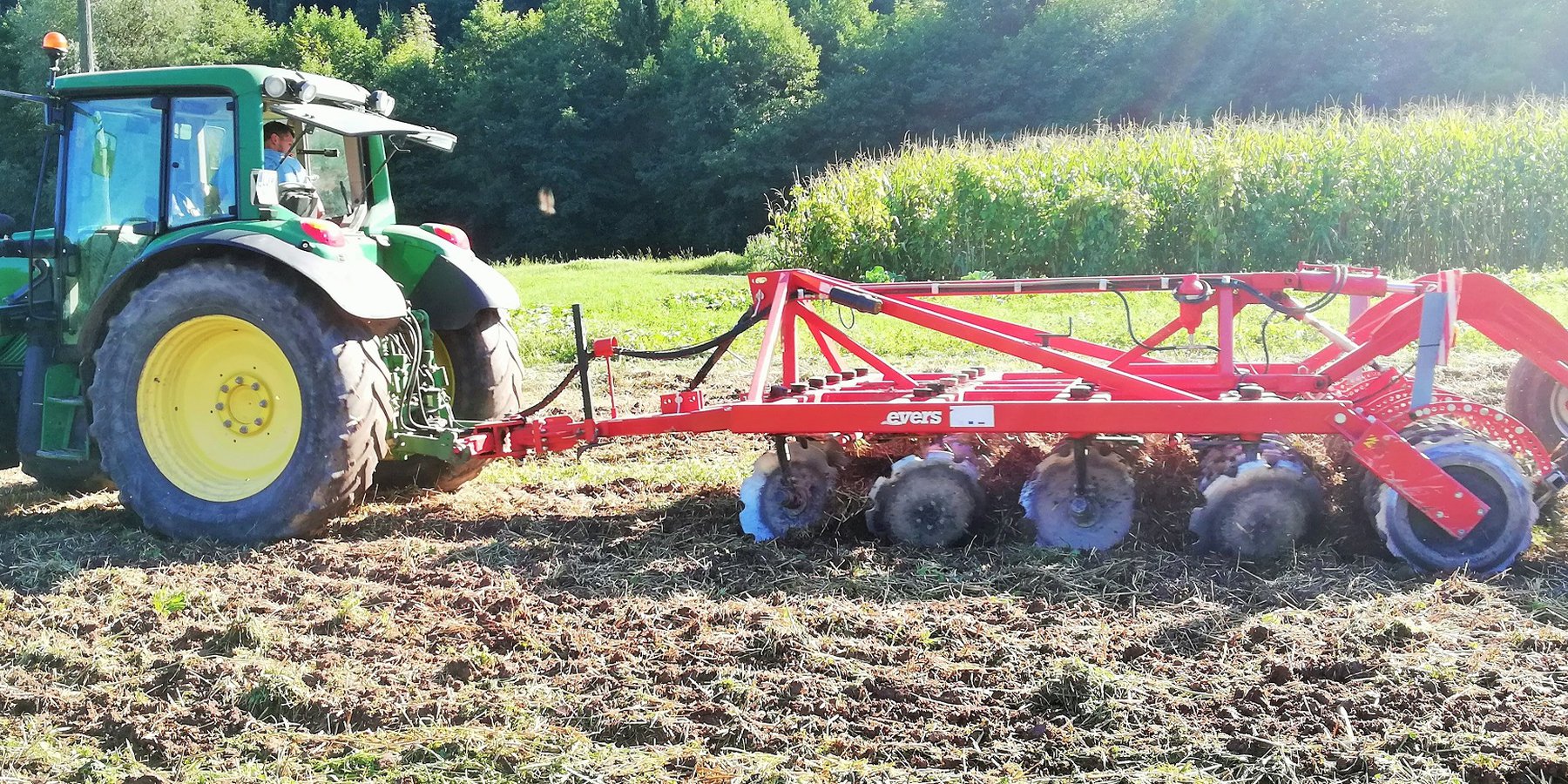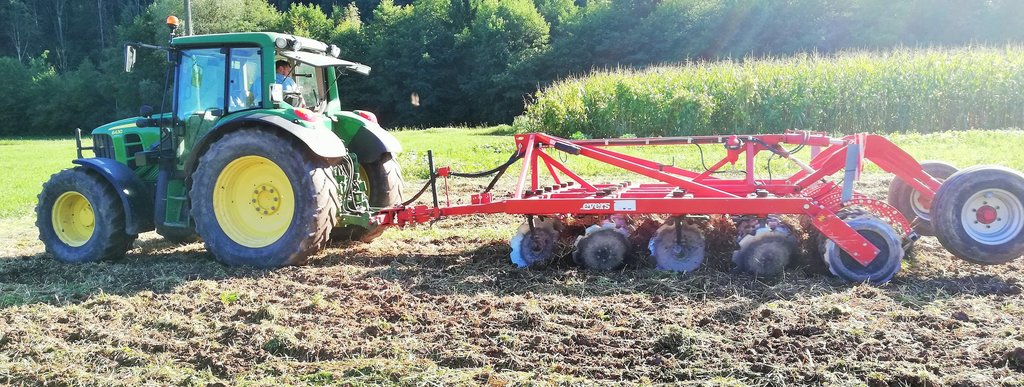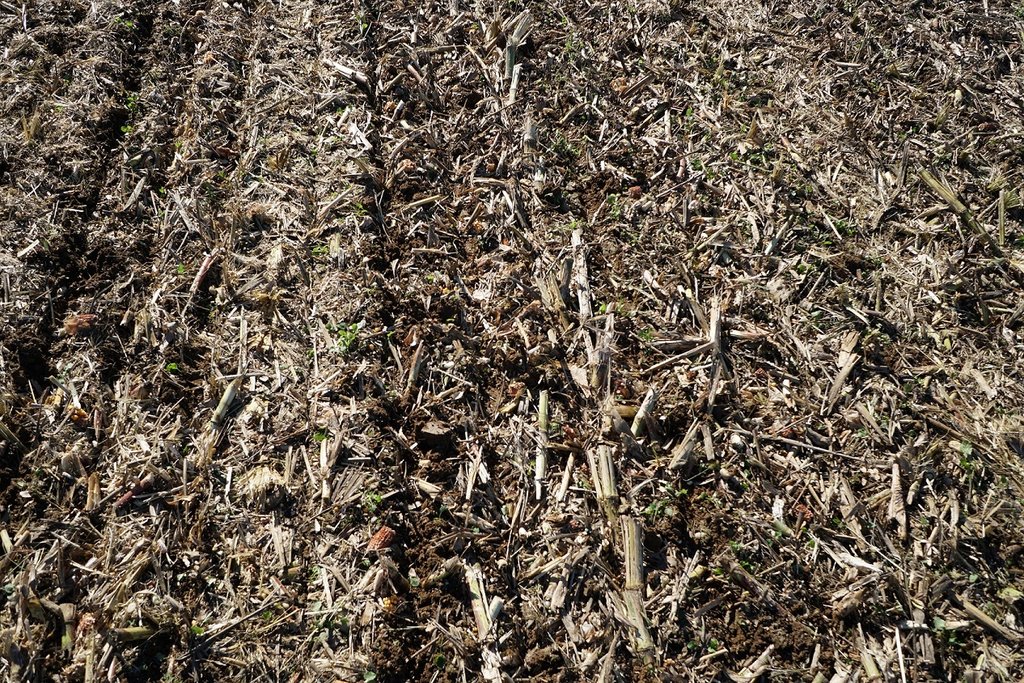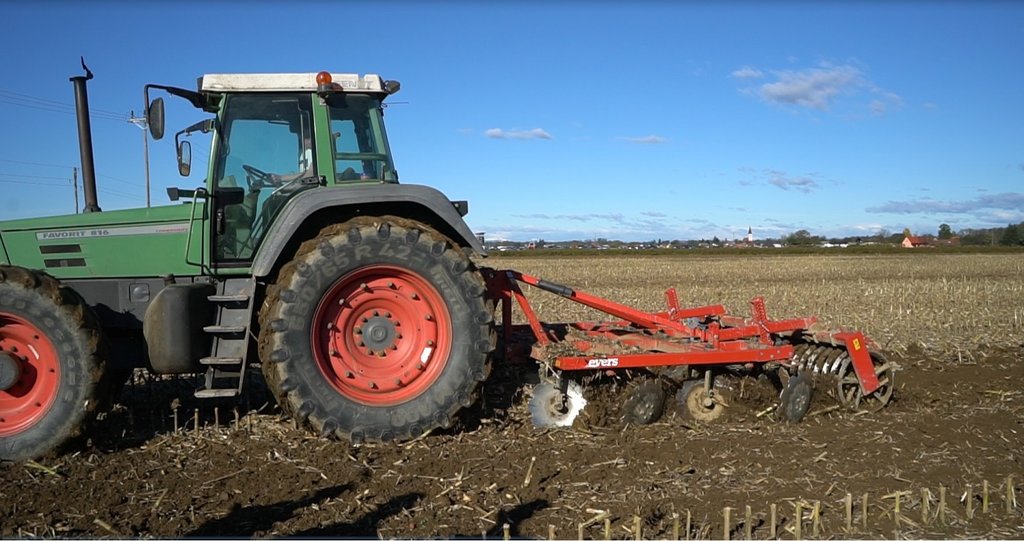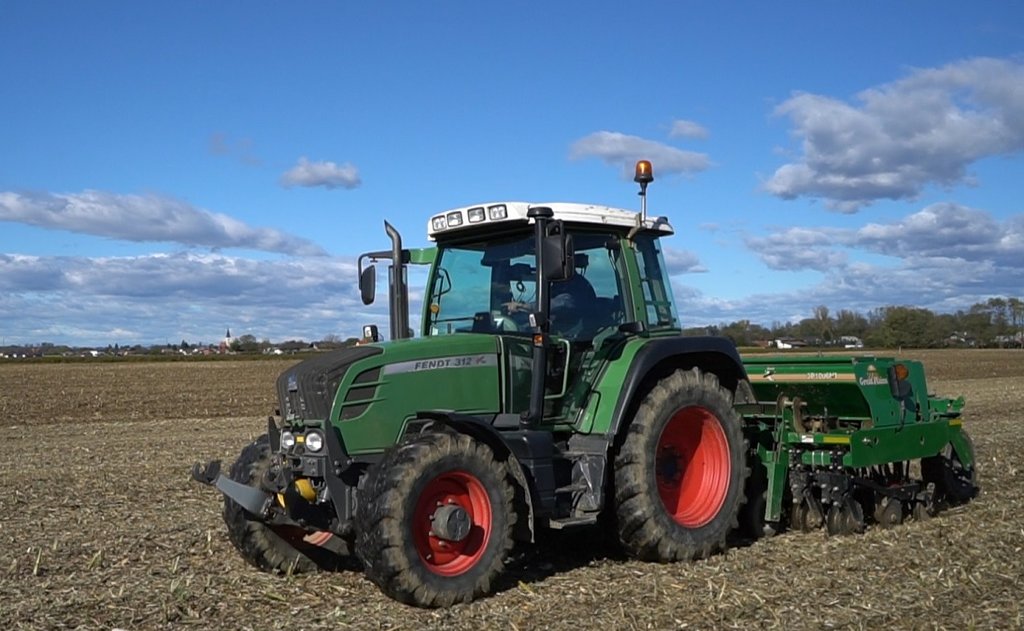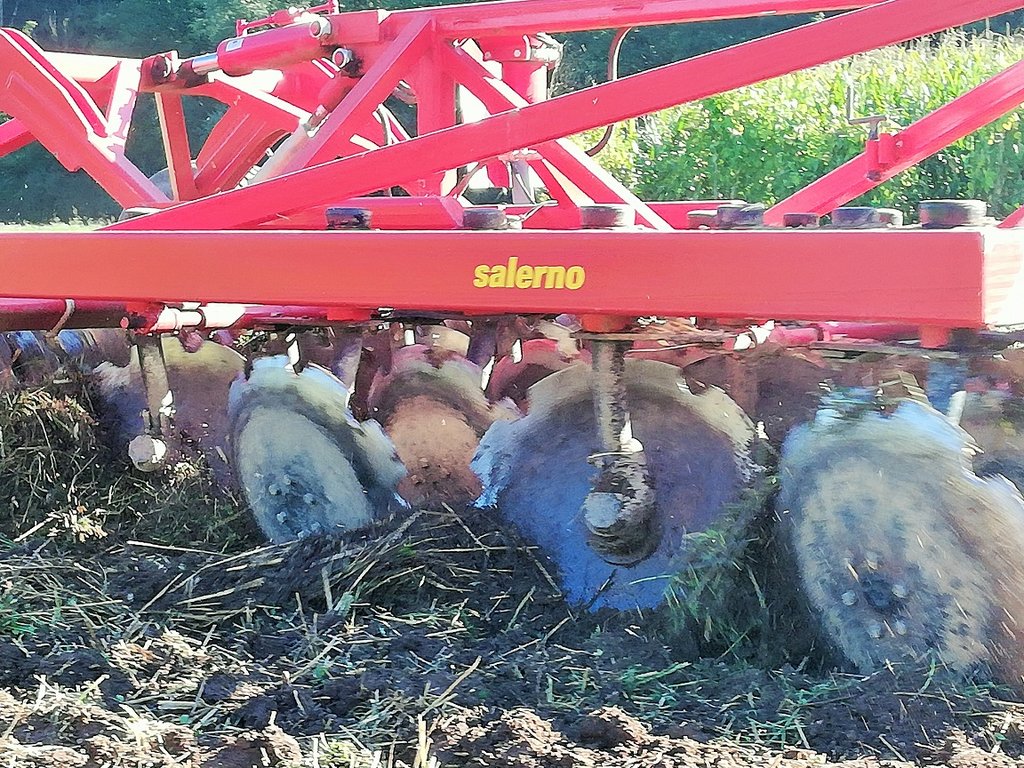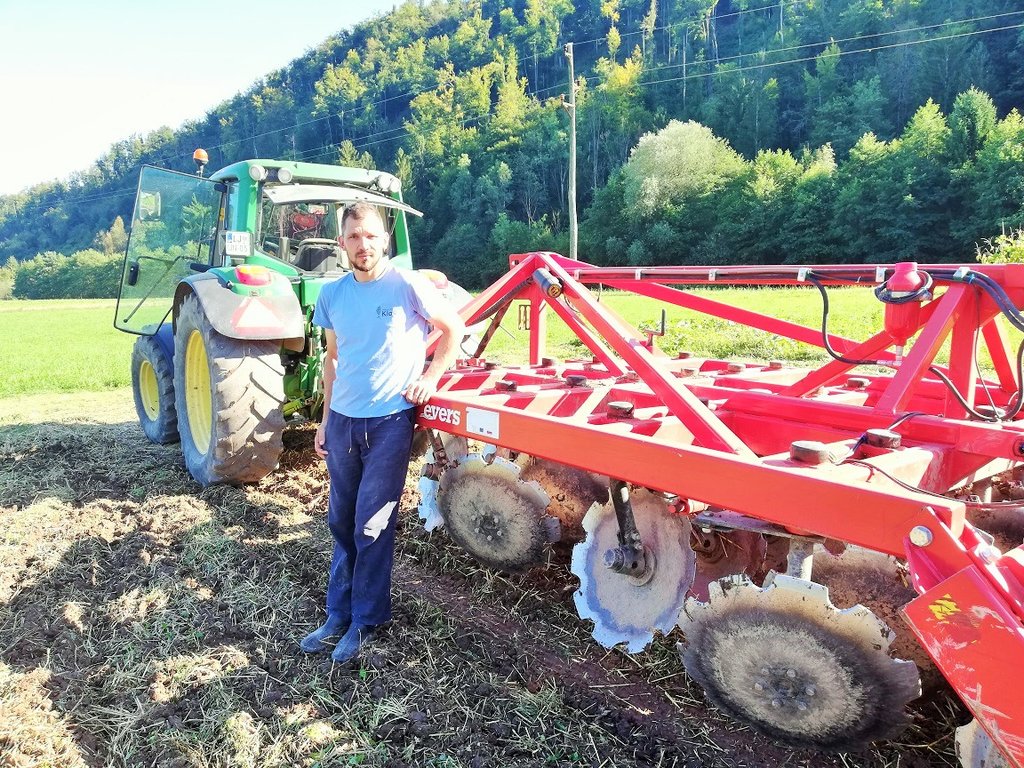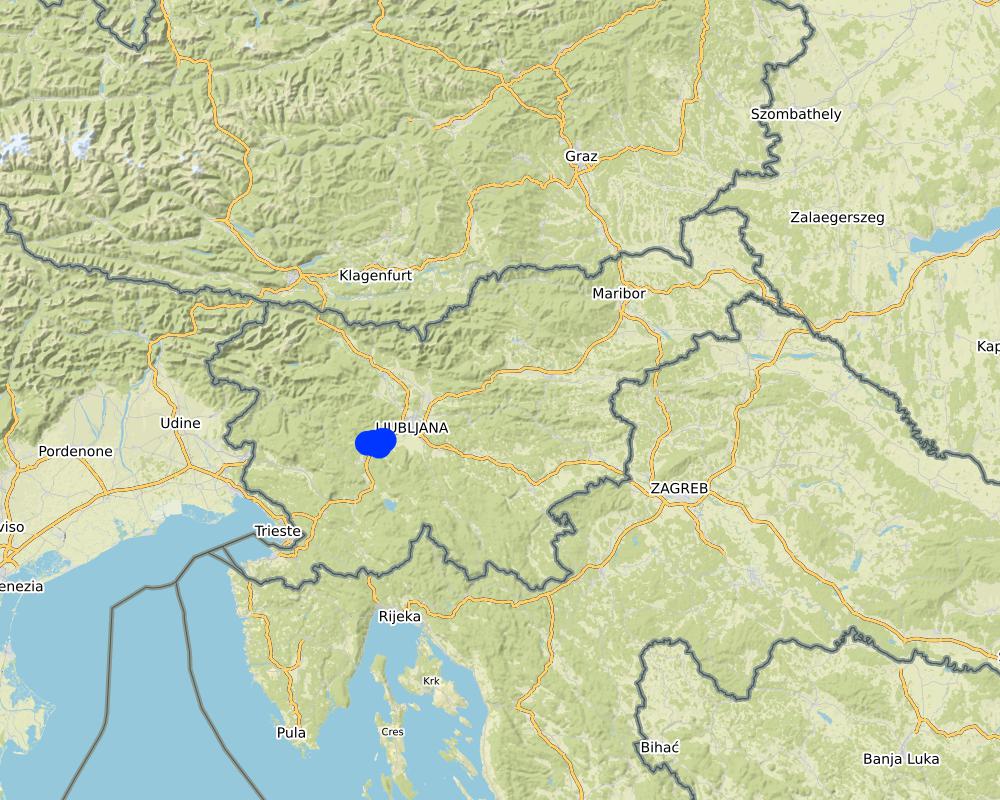Conservation tillage with incorporated mulched plant residues (mulch-till) [Slovénie]
- Création :
- Mise à jour :
- Compilateur : Matjaz Glavan
- Rédacteur : –
- Examinateur : Rima Mekdaschi Studer
Ohranitvena obdelava tal z vdelavo mulčenih rastlinskih ostankov
technologies_5494 - Slovénie
Voir les sections
Développer tout Réduire tout1. Informations générales
1.2 Coordonnées des personnes-ressources et des institutions impliquées dans l'évaluation et la documentation de la Technologie
Personne(s)-ressource(s) clé(s)
exploitant des terres:
Mrzlikar Anton
Family farm
Slovénie
Nom du projet qui a facilité la documentation/ l'évaluation de la Technologie (si pertinent)
Interactive Soil Quality assessment in Europe and China for Agricultural productivity and Environmental Resilience (EU-iSQAPER)Nom du ou des institutions qui ont facilité la documentation/ l'évaluation de la Technologie (si pertinent)
Department for Agronomy, University of Ljubljana - Slovénie1.3 Conditions relatives à l'utilisation par WOCAT des données documentées
Le compilateur et la(les) personne(s) ressource(s) acceptent les conditions relatives à l'utilisation par WOCAT des données documentées:
Oui
1.4 Déclaration sur la durabilité de la Technologie décrite
Est-ce que la Technologie décrite ici pose problème par rapport à la dégradation des terres, de telle sorte qu'elle ne peut pas être déclarée comme étant une technologie de gestion durable des terres?
Non
2. Description de la Technologie de GDT
2.1 Courte description de la Technologie
Définition de la Technologie:
Conservation tillage with incorporated mulched plant residues (mulch-till) of harvested crop or a green manure that are part of the rotation). Crop residues are partially incorporated/mixed in topsoil layer (down to 10 cm) using a disc harrow, chisel plough, sweeps, field cultivators, that leave more than 30% of the soil surface covered with crop residue. Technology contributes to less soil disturbance, increase of soil organic matter, better soil structure and better water holding capacity of soils.
2.2 Description détaillée de la Technologie
Description:
1. The technology of conservational tillage with incorporated mulched plant residues (mulch-till) is applied in flatlands around the Municipality of Vrhnika with an average altitude of 290 m.a.s.l. Average annual precipitation is 1400 mm. The area is characterized with often stormy precipitation events and occasional summer droughts. A farmer applies this technology on various soil types from silty loam to silty clay Gleysol to organic Histosol soils (peat). Soils in the area are generally moderately deep to deep with medium soil organic matter (Gleysol) of 3-7% or with a high share of organic matter (Histosol) of >20% (Ljubljana moors). The area has good availability of surface water and groundwater of good drinking quality. Gleysol areas are drained (drainage systems) to prevent floods to enable cultivation. Histosol areas are drained (open-channel drainage systems) to enable arable crop production. However, due to high groundwater and many surface water sources, certain areas are regularly flooded during flood events mostly in late autumn, winter and spring. Salinity is not a problem due to high precipitation and leaching. Farmer practices rotational agriculture. Less than 5% of income coming from off-farm activities. The examined farm household has an average wealth and is fully mechanized/motorized. the farm has good access to services and infrastructure. The examined farm is medium in scale with land partly owned by the land user and partly leased from other private owners.The general biodiversity of the area is medium on Gleysols to high on Histosol where nature protection Landscape Park of Ljubljansko Barje (The Ljubljana Moors Landscape Park) is located.
Part of the farmers land parcels is located inside boundaries of Krajinski park Ljubljansko barje /Ljubljana Moor Landscape park. Park takes a lot of actions to secure peat soils. This almost 16,000 hectares large lowland marshy plain is marked by an interminable mosaic of grasslands, broadleaf woodlands, fields, ditches and hedges.
The farmer decided to abandon conventional ploughing technology and to start with conservational tillage technology when he noticed that the organic layer of peat soils in these areas started to become thinner. Farmer introduced this technology to preserve peat soils of Ljubljana Moors on his parcels in 2015. With ploughing, peat was mixed and decomposing - mineralise. In 18th-century peat layers of up to 2m depth were exploited for the same use as firewood. Only shallow layers of peat soil (up to 1 m) are still covering agricultural areas. As peat is a source of fertility farmers are seeking ways of preserving it. Farmer Anton Mrzlikar took a lead and started with conservational tillage with incorporated mulched plant residues (mulch-till).
Video https://vimeo.com/97415985 presents the effects of conservational tillage with incorporated mulched plant residues (mulch-till) on soil stability. This is a simulation of abundant summer rain and its impact on the tilled soils in terms of water infiltration capacity and erodibility. The result of this simulation is presented very clearly. It shows the difference between long-term conventional versus conservation tillage (mulch-till). Conventional tillage ploughs the top 25-28 cm of the soil at least once or twice a year. The soil is inverted, its structure breaks down and the surface is left bare. The first raindrops break the structural aggregates causing soil surface siltation and blockage of the soil pores. Thus vertical water flow is blocked and redirected as surface runoff, causing distinct erosion. If fertilizers and pesticides are used, the water flow will transport them, along with the soil particles, to surface waters where they cause pollution or surface ponding on the fields. This leads to an uneven distribution of substances across the field surface.
In conservation tillage (mulch-till), a shallow, 10 cm layer of topsoil is mixed with organic residues which are thus retained near and on the surface. In this way, soil structure is reinforced with good soil water infiltration and absorption. Despite heavy rainfall, the soils do not show any signs of erosion. There is no surface flow. Water drains into the soil vertical flow where it is available to the plants.
2. The farmer usees of 4-row-disk harrow tillage machinery (vario-disc) on arable fields for all crop types. When cultivating fields he crosses fields 1 - 2 times (depends on soil moisture). Every few years he uses chisels to break and shatters (aerate) the soils (depends on crop type - cereals and drought years). After main/first crop he seeds various cover crops (if fodder is needed they harvested it otherwise is used for green manure). He uses manure 30-40 t/ha. He applies typical dairy cow farm rotation (cereals/maize/soya/grass-clover mix). Cover crops are classified as rapes, cereals, oats, grass-clover, grass.
3. The main function is an increase of organic matter, retain water, increase soil biodiversity, stabilise soil structure in the soils and reduce water erosion, as well as reduce energy consumption and costs. This leads to better (1) productivity due to nutrients slow-release, (2) better water holding capacity and (3) decreased soil compaction threat. The technology was introduced to prevent decomposition of organic matter on Ljubljana moor peat soils.
4. Major inputs needed to establish is to change machinery and to gain new knowledge and experiences. They had to buy 4-row disc harrows, chisels plough and new seeders (maize). Seeding machines for cereals and oilseed rape are hired from other farmers. It is important that soils are covered all year round. Soils must be dry when cultivated.
5. The benefits are (1) increase in soil organic matter, (2) increase soil water holding capacity, (3) to maintain soil productivity, (4) increase in yields quantity and quality, (5) reduce energy consumption, (6) reduce workload - 3-4 times less time used for cultivation, (7) reduce costs.
6. Land users like (1) reduced workload and energy consumption, (2) positive impact on soil fertility and stability, (3) preserves organic matter - decrease peat soils decomposition, (4) as soils need to be covered all the time they produce more feed for cows, (5) smooths surface fields, (6) with disc harrow is easy to till soils even when residues are present on fields, (7) less soil compaction
Land users dislike: (1) investment cost for new machinery are high, (2) time to change in doing things and practice, (3) on clay soils (Gleysol) surface ponding is occurring, (4) soils need to be drier for tilling in comparison to ploughing.
2.3 Photos de la Technologie
2.4 Vidéos de la Technologie
Commentaire, brève description:
This is a simulation of abundant summer rain and its impact on the tilled soils in terms of water infiltration capacity and erodibility. The result of this simulation is presented very clearly. It shows the difference between long-term conventional versus conservation soil tillage.
Conventional tillage ploughs the top 25-28 cm of the soil at least once or twice a year. The soil is inverted, its structure breaks down and the surface is left bare. The first raindrops break the structural aggregates causing soil surface siltation and blockage of the soil pores. Thus vertical water flow is blocked and redirected as surface runoff, causing distinct erosion. If fertilizers and pesticides are used, the water flow will transport them, along with the soil particles, to surface waters where they cause pollution or surface ponding on the fields. This leads to an uneven distribution of substances across the field surface.
In conservation tillage (mulch-till), a shallow, 10 cm layer of topsoil is mixed with organic residues which are thus retained near and on the surface. In this way, soil structure is reinforced with good soil water infiltration and absorption. Despite heavy rainfall, the soils do not show any signs of erosion. There is no surface flow. Water drains into the soil vertical flow where it is available to the plants.
Date:
04/12/2017
Lieu:
Ljubljana, Biotechnical Faculty, University of LJubljana
Nom du vidéaste:
Rok Mihelič, Marko Zupan, Matjaž Glavan - Agronomy Department, Biotechnical Faculty, University of Ljubljana
Commentaire, brève description:
Presenting 4-row disch harrow in action.
Date:
12/04/2017
Lieu:
Slovenia
Nom du vidéaste:
Rok Mihelič, Agronomy Department, Biotechnical Faculty, University of Ljubljana
Commentaire, brève description:
Presening seeder (cereals/oilseed rape) in action and condition of soil surface after tillage and seeding.
Date:
12/04/2017
Lieu:
Slovenia
Nom du vidéaste:
Rok Mihelič, Agronomy Department, Biotechnical Faculty, University of Ljubljana
2.5 Pays/ région/ lieux où la Technologie a été appliquée et qui sont couverts par cette évaluation
Pays:
Slovénie
Région/ Etat/ Province:
Central Slovenia
Autres spécifications du lieu:
Podlipa, Vrhnika. This specific farmer applies this technology on Ljubljansko barje, othewise is applied all over Slovenia
Spécifiez la diffusion de la Technologie:
- appliquée en des points spécifiques ou concentrée sur une petite surface
Est-ce que les sites dans lesquels la Technologie est appliquée sont situés dans des zones protégées en permanence?
Oui
Si oui, veuillez préciser:
Part of his land parcels is located inside boundaries of Krajinski park Ljubljansko barje /Ljubljana Moor Landscape park. Park takes a lot of actions to secure peat soils. This almost 16,000 hectares large marshy plain is marked by an interminable mosaic of grasslands, broadleaf woodlands, fields, ditches and hedges.
http://www.ljubljanskobarje.si/?lang=en
Map
×2.6 Date de mise en œuvre de la Technologie
Indiquez l'année de mise en œuvre:
2015
Si l'année précise est inconnue, indiquez la date approximative: :
- il y a moins de 10 ans (récemment)
2.7 Introduction de la Technologie
Spécifiez comment la Technologie a été introduite: :
- grâce à l'innovation d'exploitants des terres
Commentaires (type de projet, etc.) :
Farmer introduced this technology to preserve peat soils of Ljubljana Moors on his parcels in 2015. With ploughing, peat was mixed and decomposing - mineralise. In 18th-century peat layers of up to 2m depth were exploited for the same use as firewood. Only shallow layers of peat soil (up to 1 m) are still covering agricultural areas. As peat is a source of fertility farmers are seeking ways of preserving it. Farmer Anton Mrzlikar took a lead and started with mulch-till.
3. Classification de la Technologie de GDT
3.1 Principal(aux) objectif(s) de la Technologie
- réduire, prévenir, restaurer les terres dégradées
- s'adapter au changement et aux extrêmes climatiques et à leurs impacts
- créer un impact économique positif
3.2 Type(s) actuel(s) d'utilisation des terres, là où la Technologie est appliquée
Les divers types d'utilisation des terres au sein du même unité de terrain: :
Non

Terres cultivées
- Cultures annuelles
Cultures annuelles - Précisez les cultures:
- céréales - maïs
- cereals - maize - legumes - grass-clover mix
Système de cultures annuelles :
Maïs ou rotation similaire de foin/pâturage
Nombre de période de croissance par an: :
- 1
Est-ce que les cultures intercalaires sont pratiquées?
Non
Est-ce que la rotation des cultures est appliquée?
Oui
Si oui, veuillez préciser:
cereals/maize/soy/grass-clover mix, additionally cover crops after main crop (soil must be covered all year round
3.3 Est-ce que l’utilisation des terres a changé en raison de la mise en œuvre de la Technologie ?
Est-ce que l’utilisation des terres a changé en raison de la mise en œuvre de la Technologie ?
- Non (Passez à la question 3.4)
3.4 Approvisionnement en eau
Approvisionnement en eau des terres sur lesquelles est appliquée la Technologie:
- pluvial
3.5 Groupe de GDT auquel appartient la Technologie
- perturbation minimale du sol
3.6 Mesures de GDT constituant la Technologie

pratiques agronomiques
- A2: Matière organique/ fertilité du sol
- A3: Traitement de la couche superficielle du sol
A3: Différenciez les systèmes de travail du sol:
A 3.2: Reduced tillage (> 30% soil cover)
3.7 Principaux types de dégradation des terres traités par la Technologie

érosion hydrique des sols
- Wt: perte de la couche superficielle des sols (couche arable)/ érosion de surface

dégradation physique des sols
- Pc: compaction
- Ps: affaissement des sols organiques, tassement des sols
3.8 Prévention, réduction de la dégradation ou réhabilitation des terres dégradées
Spécifiez l'objectif de la Technologie au regard de la dégradation des terres:
- réduire la dégradation des terres
Commentaires:
It is impossible to prevent degradation in the form of peat soil mineralisation in agricultural soils.
4. Spécifications techniques, activités, intrants et coûts de mise en œuvre
4.1 Dessin technique de la Technologie
4.2 Informations générales sur le calcul des intrants et des coûts
Spécifiez la manière dont les coûts et les intrants ont été calculés:
- par superficie de la Technologie
Indiquez la taille et l'unité de surface:
30 ha
autre/ monnaie nationale (précisez):
EUR
Indiquez le taux de change des USD en devise locale, le cas échéant (p.ex. 1 USD = 79.9 réal brésilien): 1 USD = :
0,9
Indiquez le coût salarial moyen de la main d'œuvre par jour:
50 EUR
4.3 Activités de mise en place/ d'établissement
| Activité | Calendrier des activités (saisonnier) | |
|---|---|---|
| 1. | Preparation of fields: Leveling depressions, reconstruction of drainage channels, using chisels to loose, break and aerate soil in deeper layers | two year before implemenation, dry soil. |
| 2. | Purchase of 4-row disc harrow | 1st year |
| 3. | Purchase of seeder for maize | 1st year |
| 4. | Purchase of seeder for cover crops | 1st year |
| 5. | Hire seeder for cereals (wheat, barley) | 1st year |
| 6. | Home made chisel plow for loosening the soil | 2nd year |
| 7. | Purchase of spraying machine | 3rd year |
| 8. | Purchase of GPS navigation system | 3rd year |
Commentaires:
The agricultural technology activities are listed in chronological order. Rotation cycle takes 3 years
4.4 Coûts et intrants nécessaires à la mise en place
| Spécifiez les intrants | Unité | Quantité | Coûts par unité | Coût total par intrant | % du coût supporté par les exploitants des terres | |
|---|---|---|---|---|---|---|
| Equipements | chisel plow material (home made) | EUR/piece | 1,0 | 6500,0 | 6500,0 | 100,0 |
| Equipements | seeder fo cover crops | EUR/piece | 1,0 | 2500,0 | 2500,0 | 50,0 |
| Equipements | seeder for maize | EUR/piece | 1,0 | 7500,0 | 7500,0 | 50,0 |
| Equipements | 4-row disk harrow | EUR/piece | 1,0 | 23000,0 | 23000,0 | 50,0 |
| Equipements | sprayer | EUR/piece | 1,0 | 12,5 | 12,5 | 25,0 |
| Equipements | GPS navigation | EUR/piece | 1,0 | 2500,0 | 2500,0 | 100,0 |
| Equipements | hire seeder for cereals | EUR/ha | 15,0 | 50,0 | 750,0 | 100,0 |
| Coût total de mise en place de la Technologie | 42762,5 | |||||
| Coût total de mise en place de la Technologie en dollars américains (USD) | 47513,89 | |||||
Si le coût n'est pas pris en charge à 100% par l'exploitant des terres, indiquez qui a financé le coût restant:
50% - Agency for agricultural payments (EU funds); 25% - sharred among farmers
Commentaires:
Cost for hiring seeder is calculated for 15ha as cereals cover 15ha of arable land.
4.5 Activités d'entretien/ récurrentes
| Activité | Calendrier/ fréquence | |
|---|---|---|
| 1. | Maintenance of 4-disc harrow | 6 time per year, before or after use of equipment |
| 2. | Maintenance of Spayer | before use nozzels check, after use cleaning |
| 3. | Maintenance of seeder for maize | before and after use |
| 4. | Maintenance of seeder for cover crops | before and after use |
4.6 Coûts et intrants nécessaires aux activités d'entretien/ récurrentes (par an)
| Spécifiez les intrants | Unité | Quantité | Coûts par unité | Coût total par intrant | % du coût supporté par les exploitants des terres | |
|---|---|---|---|---|---|---|
| Main d'œuvre | Maintenance of 4-disc harrow | hour | 6,0 | 6,25 | 37,5 | 100,0 |
| Main d'œuvre | Maintenance of Spayer | hour | 6,0 | 6,25 | 37,5 | 100,0 |
| Main d'œuvre | Maintenance of seeder for maize | hour | 4,0 | 6,25 | 25,0 | 100,0 |
| Main d'œuvre | Maintenance of seeder for cover crops | hour | 1,0 | 6,25 | 6,25 | 100,0 |
| Equipements | Lubricant cartridge for4-disc harrow | cartridge | 18,0 | 5,0 | 90,0 | 100,0 |
| Equipements | Nozzels for Spayer | nozzel | 20,0 | 4,0 | 80,0 | 100,0 |
| Equipements | Lubricant cartridge for seeder for maize | cartridge | 4,0 | 5,0 | 20,0 | 100,0 |
| Equipements | Lubricant cartridge for seeder for cover crops | cartridge | 1,0 | 5,0 | 5,0 | 100,0 |
| Coût total d'entretien de la Technologie | 301,25 | |||||
| Coût total d'entretien de la Technologie en dollars américains (USD) | 334,72 | |||||
Commentaires:
There is a big difference between conventional and conservation tillage in time spend cultivating fields.
Farmer estimates reduction in workload (no ploughing) for 3-4 times in comparison to the conventional ploughing system.
Farmer points out an increase in green mass yield (clover, grass) due to cover crops which can be used as feed for livestock or green manure. He said that the most important part of this conservational system (mulch-till) is to prevent weeds to germinate, and that's why soil needs to be covered at all times.
He also states that top and subsoil layers are loose.
He states that he still uses the same amount of plant protection products.
The use of herbicides and fertilisers is at the same range as before the shift in practice, but he expects improvements in the future when he will further enhance knowledge on crop types, rotation and cover crops.
4.7 Facteurs les plus importants affectant les coûts
Décrivez les facteurs les plus importants affectant les coûts :
The starting cost - The type of machinery is needed that has to be robust and heavy to much-till and seed into the soil.
The machinery must be in use to return a profit. Working hours are reduced now (no ploughing). Machine operators with more competences can reduce costs.
5. Environnement naturel et humain
5.1 Climat
Précipitations annuelles
- < 250 mm
- 251-500 mm
- 501-750 mm
- 751-1000 mm
- 1001-1500 mm
- 1501-2000 mm
- 2001-3000 mm
- 3001-4000 mm
- > 4000 mm
Zone agro-climatique
- humide
Heavy summer thunderstorms and showers. Local precipitation.
5.2 Topographie
Pentes moyennes:
- plat (0-2 %)
- faible (3-5%)
- modéré (6-10%)
- onduleux (11-15%)
- vallonné (16-30%)
- raide (31-60%)
- très raide (>60%)
Reliefs:
- plateaux/ plaines
- crêtes
- flancs/ pentes de montagne
- flancs/ pentes de colline
- piémonts/ glacis (bas de pente)
- fonds de vallée/bas-fonds
Zones altitudinales:
- 0-100 m
- 101-500 m
- 501-1000 m
- 1001-1500 m
- 1501-2000 m
- 2001-2500 m
- 2501-3000 m
- 3001-4000 m
- > 4000 m
Indiquez si la Technologie est spécifiquement appliquée dans des:
- non pertinent
5.3 Sols
Profondeur moyenne du sol:
- très superficiel (0-20 cm)
- superficiel (21-50 cm)
- modérément profond (51-80 cm)
- profond (81-120 cm)
- très profond (>120 cm)
Texture du sol (de la couche arable):
- fin/ lourd (argile)
Texture du sol (> 20 cm sous la surface):
- fin/ lourd (argile)
Matière organique de la couche arable:
- abondant (>3%)
Si disponible, joignez une description complète du sol ou précisez les informations disponibles, par ex., type de sol, pH/ acidité du sol, capacité d'échange cationique, azote, salinité, etc.
Organic matter on Gleysol is around 6% and on Histosol (peatland) more than 30%. Bellow the peatland is clay (called "polžarica", or "snail clay")
5.4 Disponibilité et qualité de l'eau
Profondeur estimée de l’eau dans le sol:
< 5 m
Disponibilité de l’eau de surface:
bonne
Qualité de l’eau (non traitée):
uniquement pour usage agricole (irrigation)
La qualité de l'eau fait référence à:
eaux de surface
La salinité de l'eau est-elle un problème? :
Non
La zone est-elle inondée?
Oui
Régularité:
épisodiquement
Commentaires et précisions supplémentaires sur la qualité et la quantité d'eau:
On Ljubljana moor, seasonal floods are occurring regularly due to the high water table.
5.5 Biodiversité
Diversité des espèces:
- élevé
Diversité des habitats:
- élevé
Commentaires et précisions supplémentaires sur la biodiversité:
This true especially for the Ljubljana moor.
5.6 Caractéristiques des exploitants des terres appliquant la Technologie
Sédentaire ou nomade:
- Sédentaire
Orientation du système de production:
- commercial/ de marché
Revenus hors exploitation:
- moins de 10% de tous les revenus
Niveau relatif de richesse:
- moyen
Individus ou groupes:
- individu/ ménage
Niveau de mécanisation:
- mécanisé/ motorisé
Genre:
- femmes
- hommes
Age des exploitants des terres:
- enfants
- personnes d'âge moyen
- personnes âgées
5.7 Superficie moyenne des terres utilisées par les exploitants des terres appliquant la Technologie
- < 0,5 ha
- 0,5-1 ha
- 1-2 ha
- 2-5 ha
- 5-15 ha
- 15-50 ha
- 50-100 ha
- 100-500 ha
- 500-1 000 ha
- 1 000-10 000 ha
- > 10 000 ha
Cette superficie est-elle considérée comme de petite, moyenne ou grande dimension (en se référant au contexte local)?
- moyenne dimension
Commentaires:
83 ha of agricultural land and 7 ha of forest
5.8 Propriété foncière, droits d’utilisation des terres et de l'eau
Propriété foncière:
- individu, avec titre de propriété
Droits d’utilisation des terres:
- loué
- individuel
Droits d’utilisation de l’eau:
- individuel
Est-ce que les droits d'utilisation des terres sont fondés sur un système juridique traditionnel?
Oui
Commentaires:
2/3 of land is hired from The Farmland and Forest Fund of the Republic of Slovenia
5.9 Accès aux services et aux infrastructures
santé:
- pauvre
- modéré
- bonne
éducation:
- pauvre
- modéré
- bonne
assistance technique:
- pauvre
- modéré
- bonne
emploi (par ex. hors exploitation):
- pauvre
- modéré
- bonne
marchés:
- pauvre
- modéré
- bonne
énergie:
- pauvre
- modéré
- bonne
routes et transports:
- pauvre
- modéré
- bonne
eau potable et assainissement:
- pauvre
- modéré
- bonne
services financiers:
- pauvre
- modéré
- bonne
6. Impacts et conclusions
6.1 Impacts sur site que la Technologie a montrés
Impacts socio-économiques
Production
production agricole
qualité des cultures
production fourragère
Commentaires/ spécifiez:
It increased due to the fact that soil has to be covered at all times (grass, clover, cover crops) to retain soil moisture and prevent soil erosion and to provide an optimal living condition for soil life (fauna, flora). Previously the land was left bare after harvesting cereals until autumn or even spring.
qualité des fourrages
production animale
Commentaires/ spécifiez:
Due to more fodder, the farmer managed to increase the number of livestock (dairy cows).
risque d'échec de la production
Commentaires/ spécifiez:
Due to the fact that soils are not ploughed anymore, a farmer has in wet years (more precipitation in a short period of time, especially in the springtime) problems on organic marshland and clay gley soils being fully saturated. This causes a reduction in the germination of seeds and weaker growth of plants due to hypoxia.
diversité des produits
Commentaires/ spécifiez:
More different types of cover crops in production. Some are used as nitrogen fixators or for loosening the soils with deep rots.
gestion des terres
Commentaires/ spécifiez:
The land management simplified due to fewer machines needed and less time need for land cultivation and soil preparation.
Revenus et coûts
dépenses pour les intrants agricoles
Commentaires/ spécifiez:
Less petrol nedeed for land cultivation.
revenus agricoles
Commentaires/ spécifiez:
More livestock means more income.
charge de travail
Commentaires/ spécifiez:
Workload decreased due to abandoning of ploughing.
Impacts socioculturels
connaissances sur la GDT/ dégradation des terres
Commentaires/ spécifiez:
The farmer observed positive impacts and seeks for more knowledge on this topic to improve its practice.
Impacts écologiques
Cycle de l'eau/ ruissellement
ruissellement de surface
évaporation
Sols
humidité du sol
couverture du sol
perte en sol
encroûtement/ battance du sol
compaction du sol
cycle/ recharge des éléments nutritifs
matière organique du sol/ au dessous du sol C
Biodiversité: végétale, animale
Couverture végétale
biomasse/ au dessus du sol C
Réduction des risques de catastrophe et des risques climatiques
impacts de la sécheresse
émissions de carbone et de gaz à effet de serre
Commentaires/ spécifiez:
Difficult to quantify. An increase in soil organic matter has an impact on CO2 sequestration.
6.3 Exposition et sensibilité de la Technologie aux changements progressifs et aux évènements extrêmes/catastrophes liés au climat (telles que perçues par les exploitants des terres)
Changements climatiques progressifs
Changements climatiques progressifs
| Saison | Augmentation ou diminution | Comment la Technologie fait-elle face à cela? | |
|---|---|---|---|
| températures annuelles | augmente | bien | |
| températures saisonnières | été | augmente | bien |
| précipitations annuelles | bien | ||
| précipitations saisonnières | printemps | augmente | modérément |
Extrêmes climatiques (catastrophes)
Catastrophes climatiques
| Comment la Technologie fait-elle face à cela? | |
|---|---|
| canicule | bien |
| sécheresse | bien |
6.4 Analyse coûts-bénéfices
Quels sont les bénéfices comparativement aux coûts de mise en place (du point de vue des exploitants des terres)?
Rentabilité à court terme:
légèrement négative
Rentabilité à long terme:
positive
Quels sont les bénéfices comparativement aux coûts d'entretien récurrents (du point de vue des exploitants des terres)?
Rentabilité à court terme:
légèrement positive
Rentabilité à long terme:
positive
Commentaires:
Benefits are on short term slightly negative due to investment costs, but in the long term they are positive - they pay off.
Maintenance benefits are positive for short as well as on long-term returns as less machinery and less land management activities is needed.
6.5 Adoption de la Technologie
- cas isolés/ expérimentaux
Si disponible, quantifiez (nombre de ménages et/ou superficie couverte):
Only one farmer in the area that uses this technology. On the map you can observe his fields. In the last year many of his collegues observed advantages of this technology and hires his machinery as agriculture service of tillage. In majority of times before cover crops seeding.
6.6 Adaptation
La Technologie a-t-elle été récemment modifiée pour s'adapter à l'évolution des conditions?
Non
6.7 Points forts/ avantages/ possibilités de la Technologie
| Points forts/ avantages/ possibilités du point de vue de l'exploitant des terres |
|---|
| Reduction of workload (no ploughing, less time spent on the field) |
|
Change in farmers mindset is longlasting; they are forced to gain new knowledge on technology impact on soil condition With more knowledge and better handling of technology, the cost of maintenance and time spent in the field can reduce significantly. |
|
Increase in green mass yield (clover, grass) - it can be used as feed for livestock or green manure. Soil covered all year round + residues impact increase in soil organic matter, soil water content, biological activity, soil structure, less soil compaction. |
| Points forts/ avantages/ possibilités du point de vue du compilateur ou d'une autre personne ressource clé |
|---|
| Cost and time reductions are substantial - 3-4 times less in comparsio to conventional - ploughing. |
|
Farmers became aware of the importance of conservation soil management and its impact on soil properties and finally on the process of production-chain (soil-feed-milk). With proper shaping of knowledge (advising, education) - Conservational tillage has the potential to develop into the direction of organic farming. |
| Soil structure and fertility improve |
6.8 Faiblesses/ inconvénients/ risques de la Technologie et moyens de les surmonter
| Faiblesses/ inconvénients/ risques du point de vue de l’exploitant des terres | Comment peuvent-ils être surmontés? |
|---|---|
| On heavy soils (Glaysoils) surface ponding can occur if the farmer is not experienced with using technology. | Observe weather regularly and follow meteorological forecasts. Try to avoid wet periods. |
| Weed may be a problem in the warmer part of the year, mainly after cereals are harvested. | They use herbicide and adapt or improve crop types in rotation. |
| Peatland on Ljubljana moor. There are small parcels and soil in springtime is wet prohibiting to cultivate at any time (high water table). | Observe weather regularly and follow meteorological forecasts. They have to observe soil water content conditions periodically at peatland parcels. |
| Faiblesses/ inconvénients/ risques du point de vue du compilateur ou d'une autre personne ressource clé | Comment peuvent-ils être surmontés? |
|---|---|
| Farmers still need to use herbicides as weeds are a problem especially in the early stage of crop growing (narrow-leaf) and in the last stage when crops go into senescence and light gets to the ground (broad-leaf). |
As this is a conventional type of farm, they use herbicides. However, with the promotion of organic agriculture, the expansion of vegetable production, and innovations in GPS and sensors technology hoeing/weeding machines/equipment is getting popular. This problem is even more problematic in light/alluvial soils. |
| Surface ponding on heavy soils is a problem in case of longlasting rain periods in spring, which are due to climate change more often in the described area. |
It is crucial to use chisel plow in this soils to break soil layers deeper and provide drainage potential of this soils. In light alluvial soils, this problem is not observed. |
| When a farmer in under Slovenian agricultural conditions decides to change from conventional to conservation tillage, it has to change all machinery. | Farmers need to get as much as possible information on technology. Farmers have to make a business plan. EU funds can help with subsidy payments for investments on the farm (approx. 50-60%). |
7. Références et liens
7.1 Méthodes/ sources d'information
- visites de terrain, enquêtes sur le terrain
1 farmer
- interviews/entretiens avec les exploitants des terres
1 farmer
- interviews/ entretiens avec les spécialistes/ experts de GDT
1 specialist
Quand les données ont-elles été compilées (sur le terrain)?
10/05/2019
7.3 Liens vers les informations pertinentes en ligne
Titre/ description:
OHRANITVENA OBDELAVA TAL –STANJE V SLOVENIJI
URL:
http://www.digitalna-knjiznica.bf.uni-lj.si/du1_ograjsek_simon.pdf
Titre/ description:
Izzivi uvajanja konzervirajoče (ohranitvene) obdelave tal
URL:
http://www.kmetzav-mb.si/Lombergar_18/Lomb_5_2_18.pdf
Titre/ description:
NOVE TEHNOLOGIJE IN SODOBNI TRENDI OBDELOVANJA TAL
URL:
http://www.kgzs-ms.si/wp-content/uploads/2018/04/STAJNKO_NOVE-TEHNOLOGIJE.pdf
Titre/ description:
Ohranitvena obdelava : primerjava lastnosti mehansko obdelanih in neobdelanih prsti
URL:
https://www.dlib.si/details/URN:NBN:SI:DOC-LTCNTC4J
Titre/ description:
SZOORT - Slovensko združenje za ohranitveno obdelavo in rodovitnost tal
URL:
http://www.szoort.si/
Titre/ description:
Ohranitveni način obdelave tal
URL:
https://www.program-podezelja.si/sl/247-eup/izmenjevalnik-idej/seznam-izzivov/759-ohranitveni-obdelave-tal
Liens et modules
Développer tout Réduire toutLiens
Aucun lien
Modules
Aucun module trouvé


